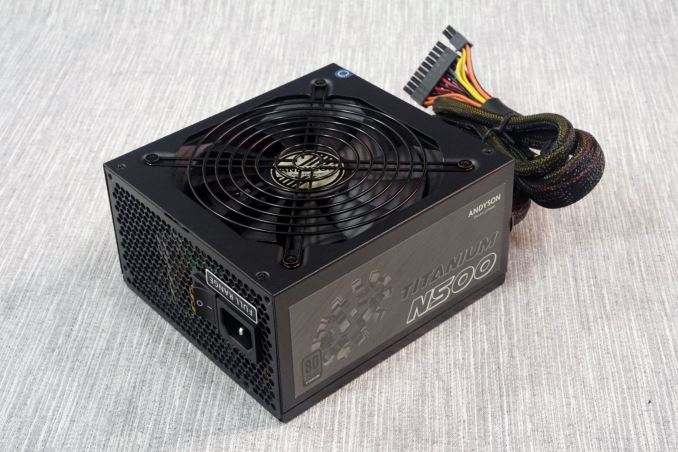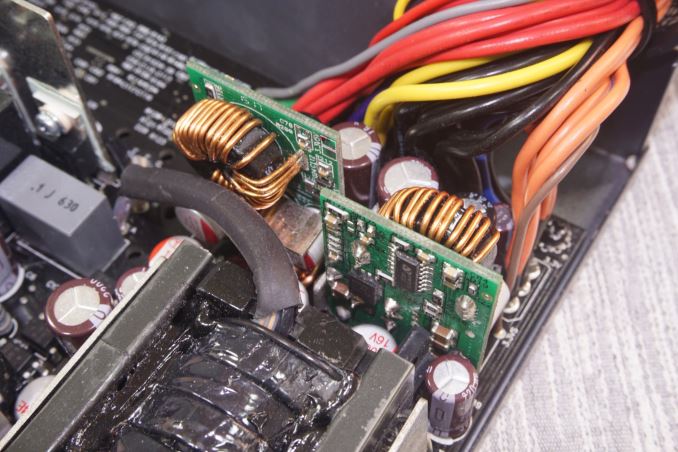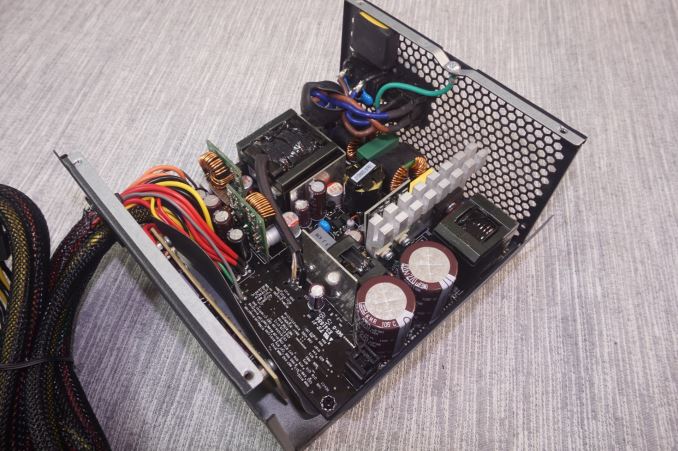The Andyson N500 Titanium PSU Review: High Efficiency For The Common PC
by E. Fylladitakis on October 8, 2015 8:00 AM EST- Posted in
- Cases/Cooling/PSUs
- PSUs
- 500W
- Andyson
- 80Plus Titanium
Conclusion
Andyson's motives surrounding the release of the 80Plus Titanium certified N series are as clear as day - the company wants to market top efficiency units with reasonable power output at retail prices. Currently, most 80Plus Titanium PSUs that have found their way into the retail market are behemoths with three times higher power output than what most home and gaming PCs require. Although technically only the N700 Titanium is actually tested and certified, the N500 is based on the same platform and our testing proved that it should have no problem meeting the certification levels either. With an output of 500 Watts, the N500 Titanium is capable of powering the vast majority of home and gaming PCs. Even with a single high-end graphics card installed, the N500 Titanium is likely to be sufficient for the system.
The problem with designs capable of reaching 80Plus Titanium efficiency levels is that they are very costly, preventing them from being competitive in the market. Andyson approached this issue in two ways. First, they did not spend too much effort on the aesthetics of the PSU. Visually, it is just a semi-modular black PSU with typical sleeved cables. Secondly, they managed to get very high efficiency from a relatively simple design by just using high quality components. As a matter of fact, Andyson managed to reach 80Plus Titanium efficiency levels while only using typical bridges at the primary conversion stage and a half-bridge layout at the primary of the transformer. Most designers would struggle to reach 80Plus Platinum efficiency levels using that setup.
Although Andyson obviously strove to keep the retail price low, they did not make cuts on quality. In fact, some parts of the PSU are unreasonably oversized as well. For example, the current rating of the two input rectifying bridges should be enough for a PSU three times more powerful. The exclusive use of Japanese (Nippon Chemi-Con and Toshin Kogyo) electrolytic capacitors and Teapo solid-state polymer capacitors should satisfy even the most demanding of users.
Despite that the N500 Titanium is not the prettiest PSU ever made, its good electrical performance, very high efficiency and great quality are sure to entice those seeking a top-performance unit near the 500 Watt power range. The MSRP of $110 for the N500 Titanium reasonable, considering that 550-650W 80Plus Gold certified units usually retail for $80-100. However, much like the Platinum R 1200W that we reviewed some months ago, it is exceedingly difficult to find in the US at this point of time, or almost anywhere outside Eastern Asia for that matter. Andyson is having serious distribution problems, with very few of their products being actually available in most markets. Hopefully, as the company grows, that issue will solve itself.
Finally, one should also consider that the premium price tag of the 80Plus Titanium efficiency units is probably not worth it if all that matters to the user are power cost savings. The higher efficiency will certainly reduce the energy consumption of a PC, but the cost savings over an 80Plus Gold unit are small. Such calculations depend on the local cost of energy but a quick assessment reveals that it usually would take several years to cover the extra initial cost. This is even truer for a 500 Watt model, as the absolute energy savings are even lower.













46 Comments
View All Comments
Murloc - Thursday, October 8, 2015 - link
what is 10% when the consumption is low?Also the 80plus certifications are created to take into account that the best efficiency is achieved at certain loads.
This is why they have certifications instead of a single efficiency number.
The consumer gets the information on efficiency synthetized in a single artificial indicator.
CaedenV - Thursday, October 8, 2015 - link
What, you are going to complain about 5w? On a 'normal' PSU you would be looking at 50-60% efficiency at such low loads.HOOfan 1 - Thursday, October 8, 2015 - link
Not sure what you mean by normal. No PSU worth buying on the market today is going to be that inefficient at 50W draw.80 Plus Titanium calls for 90% efficiency at 10% load, so at 50W, this unit should be 90% efficient. None of the other 80+ Certifications specify efficiency at 10% load.
Using Techpowerup, here are some numbers for 80 Plus Gold units.
Seasonic G550 84% efficient at 59W draw retails for $80
EVGA Supernova G2 650 84.77% efficient at 59W draw retails for $100
RussianSensation - Thursday, October 8, 2015 - link
I don't think you know how to reach charts.http://www.anandtech.com/show/9663/the-andyson-n50...
At 50W rating, the power efficiency is >90%.
It seems you also didn't even read the review:
"As expected, the efficiency of the N500 Titanium is astonishing. The unit reached a maximum conversion efficiency of 95.2% at 50% load and an average of 94.1% within the nominal load range (20% to 100% of the unit's capacity). Not only that, but the low load efficiency is comparatively excellent as well, with the N500 Titanium maintaining an energy conversion efficiency of 91.4% at 10% load and 84.6% at 5% load. An efficiency greater than 84% with a load of merely 27.5 Watts on a 500W unit is outstanding."
@ 10% load it's 91.4% to be precise.
Next time before trying to criticize a product, maybe you should actually read the review.
HOOfan 1 - Thursday, October 8, 2015 - link
Are you replying to me or Shadowmaster? I was correcting Shadowmaster when he said it was only 85% efficient at 44w by saying it was at least 90% efficient at 50w. Then I corrected Caedenv when he said other PSUs are only 50% efficient at that losd. So basically if you are refering to me then you just backed up what I already posted...DanNeely - Thursday, October 8, 2015 - link
Actually it is. At idle loads a 80+ Gold PSU would be about 75% efficient; Titanium is the first standard to set a 10% efficiency requirement at all. Squeezing a tenth of a watt of consumption out of fixed power components is much harder than trying to get a tenth of a percent improvement at high loads.DzanZeMan - Thursday, October 8, 2015 - link
Actually, 84.6% effeciency at 5% (27.5 watts) and 91.4% effeciency at 10%. details... details... amirite?RussianSensation - Thursday, October 8, 2015 - link
Exactly. The guy goes off criticizing the product when in the review's description and in the charts it's as clear as can be that at 10% load efficiency is at least 90%.ShieTar - Friday, October 9, 2015 - link
Almost "rite". Its a 500W unit, so 5% are 25W, not 27.5W.Nitpicking, I know ;-)
Samus - Friday, October 9, 2015 - link
Anything over 80% efficiency at <10% load is excellent.85% is unbelievable. As an electrical engineer I can't even wrap my head around how efficient that is. The analog ballasts and transformers I'm used to working with are usually around 70% efficient at idle\no load state. Even a Class 5 transformer to charge your phone saps around half a watt hour without a load, and since those devices are typically 3w, that's about 80% efficient and as good as consumer electronics often get.